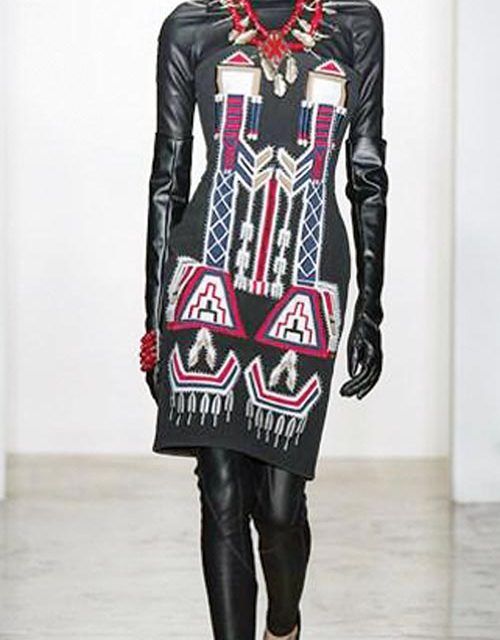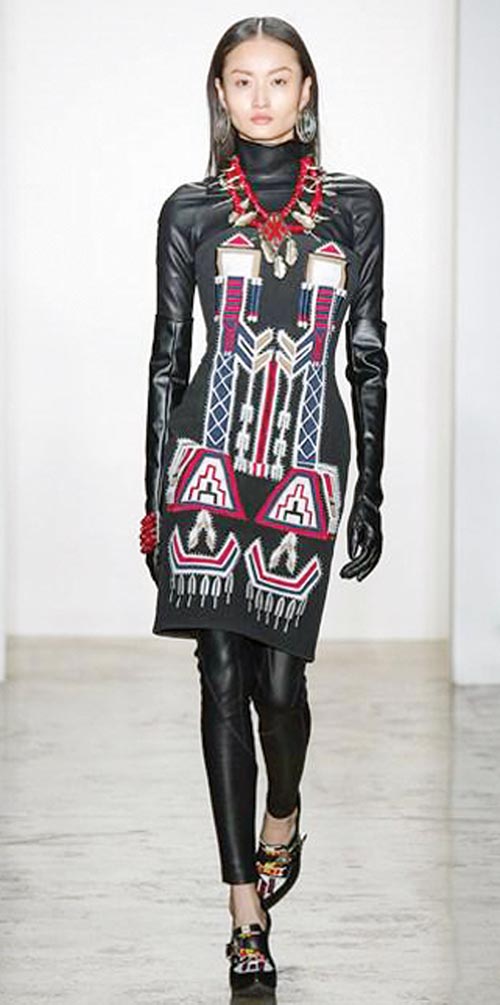
Tribute or theft?

Some Natives shocked at Fashion Week designs
WINDOW ROCK

During the Fall/Winter 2015 New York Fashion Week this month, a model strutted down the runway in a dress with the Navajo Yei design printed on it.
The dress was part of London-based clothing line KTZ and was created by Marjan Pejoski, who debuted his 2015 fall/winter line on Feb. 17 and many of his designs were Native-inspired. In an interview featured on Women’s Wear Daily‘s website, Pejoski is quoted saying that his lineup is a tribute to “the primal woman indigenous to this land.”
But some “primal” women, and men too, are pretty upset about it.
The Navajo Times tried numerous times to get a response from Pejoski’s and his public relations representative, Kelly Cutrone, but they have yet to respond.
David J. Tsosie, Navajo healer and former president of Azee’ Bee Nahaghá of Diné Nation, said the Navajo Yei being shown in that manner is disrespectful.
“They’re desecrating the images and what it represents,” he said, because in Navajo culture and tradition the Yeis are spiritual deities, not to be depicted lightly.
“The Yeis are the deities that are sought out to restore harmony and beauty back into the life of people,” Tsosie added, and they also restore the health of the patients during the Yei Beii Cheii ceremony.
Tsosie said, “You have to be a Navajo in order to understand these deities, and for a white person, they don’t really have any understanding to what it represents. To them, it’s just a form of art.”
As far as the Yei design being used in any type of clothing, Tsosie said he has knowledge of them being woven into traditional rug dresses, but “you have to be ordained in order to use that design to make it into a rug.”
Navajo designer Irene Begay has been weaving since she was a little girl, having been taught by her mother.
When she turned 15, Begay said she went through a ceremony called the “shásh báhnánóogáád,” which allowed her to start weaving the female Yei designs.
When told of how the Navajo Yei design was showcased on Pejoski’s dress, her immediate response was “hwólah,” but then she wanted to know where the designer got their idea because “we’re told not to copy stuff like that.”
“It’s not supposed to be pictured and put online. I have pictures of my dress but I’m not going to post it,” Begay said. “It’s because I have respect for that.”
Over the years Begay said she wove at least two rug dresses with the female yei design on it every four years. Begay said she weaves only the female Yei designs into her rug dresses, but she would never print the design on cloth.
“There’s some things that you can’t do on cloth, especially with non-Navajo,” Begay said. “I’m not trying to be prejudiced but that’s something you don’t do.”
Fellow Navajo designer Virginia Yazzie-Ballenger said she would never use the Navajo Yei on her clothes. She is the owner of Navajo Spirit, a western wear boutique.
“I wouldn’t because that’s appropriated for traditional healing ceremonies and I don’t think it should be used in clothing,” Yazzie-Ballenger said.
“The person that is using it just sees as a tribal motif and they don’t understand what it’s used for,” she added.
Yazzie-Ballenger said the reasoning behind these types of designs popping up in the fashion world is because “that is what’s trending now. The tribal, the Native look. That has been going strong for number of years. They’re just trying to capitalize on it.”
More then one of Pejoski’s designs has been scrutinized over the past week through social media and online blog posts.
Adrienne Keene, writer for Native Appropriations, posted a blog on Feb. 18 titled “New York Fashion Week Designer steals from Northern Cheyenne/Crow artist Bethany Yellowtail.”
The blog post highlights some of the designs Pejoski stole from Native designers, including Yellowtail’s design, the Navajo Yei and beadwork from the Lakota tribe. According to the website, it is a forum for discussing representations of Native peoples.
Keene, said in a phone interview, “I couldn’t believe how over the top and hurtful a lot of the designs were. It wasn’t just using Bethany’s designs, it was using any number of different tribal nations’ intellectual property.”
Yellowtail said she noticed the design as soon as it walked down the runway during New York Fashion week.
“I’ve been following them (online) all week,” Yellowtail said, adding that it was her friend and fellow artisan Jamie Okuma who saw the designs on Instagram and brought them to her attention. “I felt gutted (and) I felt erased, as if my voice and my perspective of indigenous design disappeared.”
“It was a really complex feeling, to be honest,” she added, saying that she’s worked in corporate fashion for years and has seen brands debut “Native-inspired” collections every single season. “This is nothing new or a revelation, however this one was personal because I saw the love, care, and thoughtfulness of my design spoken for me as if I am not capable of doing it myself.”
Since the design, similarities have been pointed out, Yellowtail said people are getting confused as to exactly what she is upset about.
“To be clear, I am not referring to the similar silhouette of the dress, the similar neckline of the dress, or the similar hemline of the dress; I can not claim them to be mine,” she said, but what she is referring to is “hourglass shape and figures that have strategically been placed and tribally identify as Crow designs and that of my Apsaalooke Nights dress.”
“The hourglass figure, as well as the blocked /line shapes in the arrangement of the textile is very tribally specific to the Crow people,” she added. “That textile design from my dress was inspired by my great – grandmother Irene Yellowtail/NotAfraid’s personal collection of beadwork. To me that design holds and moves forward the love, the strength, and the integrity of my family in it.”
In response to the KTZ’s showcase, Yellowtail said she will “continue to honor my designs and the source of their inspiration as I always have.”
Since the line debuted last week, Yellowtail said she has not been in direct contact with KTZ.
“Regardless of how this plays out, I will move forward in the best way I know how, which is honorable and true to the people I belong to,” Yellowtail added, saying she will keep “moving and I look forward to releasing my new collection for spring/summer.”
But, Yellowtail said she does not want to see “that KTZ dress being sold in stores this fall. With an adjustment of pattern placement and shape it can easily be changed.”
A KTZ spokeswoman did return a phone call from the Times and spoke to this reporter, but would not go on record.
To see the dress type in “KTZ 2015 Fall/Winter collection” into any search engine online and the collection will pop up.
To read the full article, pick up your copy of the Navajo Times at your nearest newsstand Thursday mornings!
Are you a digital subscriber? Read the most recent three weeks of stories by logging in to your online account.








 Highway 264,
Highway 264, I-40, WB @ Winslow
I-40, WB @ Winslow